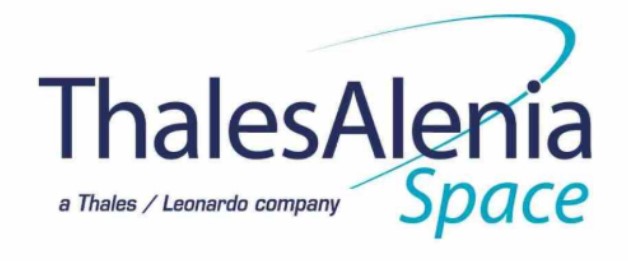-
StatusCompleted
-
Status date2016-09-02
ANTARES (AeroNauTicAl REsources Satellite based) is the phase B study designing a new Satellite Communication System for Air Traffic Management, within the Iris programme (element 10 of ARTES).
The Iris programme is the satellite-based solution for the Single European Sky ATM Research (SESAR) programme. By 2020 it will contribute to the modernisation of air traffic management by providing digital data links to cockpit crews in continental and oceanic airspace.
Within the Iris Programme, ANTARES is a study that focuses on the development of a new, purpose-built, satellite-based communication system including low-cost user terminals and an open satellite communication standard. The performance of the telecommunication protocols selected for the standard will be verified end-to-end by a Verification Test Bed.
The main objectives of the ANTARES study are:
• Specification, design, development and testing of a new Communication Standard for satellite-based Air Traffic Management communications up to the level required for international standardisation.
• Design and development of a test bed in order to validate the end-to- end performance of the new Communication Standard, on the basis of the SESAR requirements.
• Design of the overall Satellite Communication System and all its elements including Space, Ground and User Terminal Segments.
• Development of an airborne low-cost user terminal prototype.
Aviation requirements are the main drivers for the system design. In particular, safety requirements and the need of low-cost and easy to install user terminals suitable for all aircrafts flying under Instrument Flight Rules
The ANTARES project will set the basis for providing a Satellite Communication System tailored to the requirements of SESAR JU:
• ATM - dedicated Satellite Communication System purposely designed to guarantee the high reliability, availability, continuity, integrity and latency performances required for safety-of-life communication services (ATS/AOC).
• A satellite communication system designed to minimise the complexity as well as the production, installation and maintenance costs of the airborne User Terminal adopting a low cost omnidirectional antenna suitable for all the aircraft categories.
• Open Communication Standard fully devoted to the avionics needs: designed to achieve the performances required for the Single European Sky new services in continental and oceanic airspace for all types of aircrafts (including rotary-wing) and, at the same time, minimizing the L-band frequency spectrum usage. The Communication Standard is designed, so as to be suitable in any type of satellite system constellations (GEO, HEO, MEO etc.) and to operate in very large networks with high number of aircrafts. The Communication Standard specifications are available to any interested party worldwide.
This activity will contribute to the modernisation of European air traffic management.
The Satellite Communication System developed in the Iris Programme is part of the Future Radio System (FRS) infrastructure allowing aircraft to access the Air Traffic Management (ATM) entities, such as the Airline Operational Control (AOCs) and the Air Navigation Service Providers (ANSPs), by using radio communications. The ATM entities are interconnected by means of a ground distribution network, namely the Aeronautical Telecommunications Network (ATN). The ATN ground distribution network, also referred to as Pan-European Network Service (PENS), along with FRS, form the Future Communications Infrastructure (FCI).
The need of a dual link to support air-ground communication in high-density continental airspace has been recognized of key importance by the SESAR JU. This dual link will rely on two separate means of communication to avoid common points of failure; one link relies on a new terrestrial technology in L-Band, while the Satellite Communication System will provide communication services over high-density continental areas to ensure the required availability. Furthermore, the Satellite Communication System is regarded as primary mean of communication in the oceanic, remote and polar zones where no terrestrial radio technology is available.
SYSTEM ARCHITECTURE
The ANTARES Satellite Communications System is based on a constellation of geostationary satellites providing service in two major areas, namely the ECAC (European Civil Aviation Conference) area and the Atlantic ocean area.
The mobile link between aircraft and satellite is operated at L-band AMS(R)S (Aeronautical Mobile Satellite (Route) Service) frequency band (i.e. [1646.5÷1656.5 MHz] for uplink and [1545÷1555 MHz] for downlink). The fixed link between the feeder station and the satellite is operated in the frequencies currently allocated by ITU for fixed satellite services (FSS).
The overall ANTARES System architecture is composed of the following segments:
- Space Segment composed of at least two GEO satellites (one primary plus one hot redundant).
- Satellite Service Provider Ground Segment (SSP-GS) in charge of the operations and performance monitoring of the satellite network.
- Mission Management Segment (MMS) responsible for the management functions which are shared among all SSPs.
- Ground Control Segment (GCS) in charge of telemetry/telecommand with the satellites and performing payload configuration.
- User Segment envisages Civil Aviation and General Aviation user terminals.
ANTARES System Physical Architecture Overview
The ANTARES project is split in two phases:
• Phase B1, analyses requirements and provides options to SESAR and concludes by the System Requirement Review (SRR).
• Phase B2, devoted to System and Segments requirements consolidation and preliminary design (PDR), as well as to Communication Standard (CS) design and verification (CS AR).
The ANTARES project main milestones are the following:
• KOM (Kick-Off Meeting): held on 5th November 2009.
• SRR (System Requirement Review): held on 15th November 2010.
• System PDR (Preliminary Design Review): held on 5-8 November 2013.
• CS Acceptance Review (CS AR): held on November 2015.
Phase B2 started on June 2012 with the objectives of:
• Completing the design and specification of the Communication Standard (CS).
• Refining the System Design and Segment Specifications.
• Developing and procure the Verification Test Bed (VTB) including a user terminal prototype.
• Verifying the Communication Standard by using the VTB.
The Design and Specification process of the ANTARES Communication Standard was completed in May 2013.
The System PDR was successfully held and completed end of (2013).
The ANTARES project was completed with the testcampaign of the Communication Standard with the Verification Testbed in November 2015.















